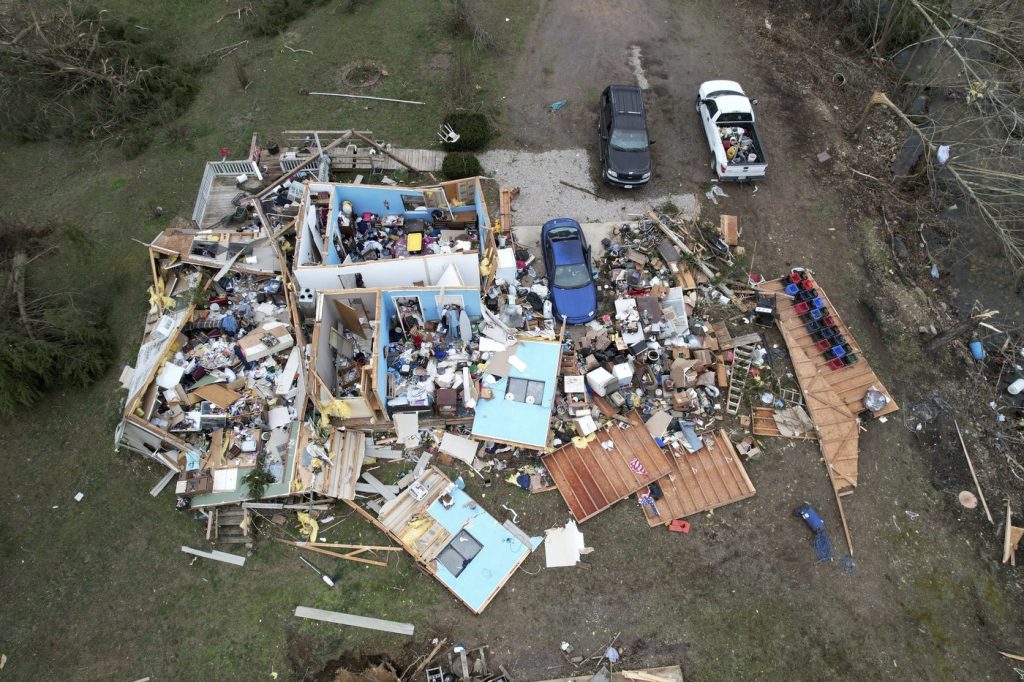PIEDMONT, Mo. (AP) — A devastating storm system, marked by violent tornadoes and fierce winds, wreaked havoc across the central and southern United States. This catastrophic weather event has resulted in the deaths of at least 32 individuals. The destruction was particularly severe in Wayne County, Missouri, where Dakota Henderson reported finding five bodies outside his aunt's demolished home amidst the rubble on Friday night.
Henderson described the scene as "very rough," emphasizing the emotional toll of the casualties. Coroner Jim Akers from Butler County characterized one site of devastation as a "debris field," with floors turned upside down and destruction rampant. Mississippi Governor Tate Reeves confirmed six fatalities across three counties, and three individuals remained unaccounted for as the storms progressed eastward into Alabama, which reported damaged structures and impassable roads. Arkansas also faced tragedies, with three confirmed deaths prompting Governor Sarah Huckabee Sanders to declare a state of emergency.
In anticipation of the storm's eastern movement, Georgia Governor Brian Kemp declared an emergency. The Georgia Emergency Management and Homeland Security Agency issued a tornado watch early Sunday, covering parts of southeast Georgia, warning residents of isolated tornadoes and high winds of 50 to 70 mph (80 to 112 kph). Governor Kemp expressed his thoughts and prayers for those affected and promised state support for recovery efforts.
The storm's initial high winds resulted in dust storms that claimed nearly a dozen lives on Friday, with a severe pileup on a Kansas highway involving around 50 vehicles leading to eight fatalities. In Texas, three individuals lost their lives in crashes that occurred during a dust storm in Amarillo.
This extreme weather system was predicted to impact a region housing over 100 million people, creating various challenges—from potential blizzard conditions in the northern sectors to heightened wildfire risks in drier southern regions. In Oklahoma, some communities mandated evacuations as over 130 wildfires were reported, and nearly 300 homes suffered damage or destruction. Governor Kevin Stitt revealed that approximately 266 square miles (689 square kilometers) had burned, lamenting the loss of a personal home in the process.
Blizzard warnings were issued for parts of far western Minnesota and far eastern South Dakota, with forecasts predicting snow accumulations of 3 to 6 inches (7.6 to 15.2 centimeters) and potentially a foot (30 centimeters). These extreme weather conditions, while alarming, are nothing out of the ordinary for March, according to experts.
Tornado activity persisted late into Saturday, particularly in regions from eastern Louisiana and Mississippi through Alabama, western Georgia, and the Florida panhandle, as indicated by the Storm Prediction Center. Witnesses like Bailey Dillon and her fiancé, Caleb Barnes, reported witnessing a massive tornado strike a nearby area in Tylertown, Mississippi, leading to catastrophic damage that included snapped trees and leveled structures.
They drove to the scene after the tornado passed and noted that numerous cabins and RVs had been flipped and destroyed, underscoring the significant devastation. Paradise Ranch RV Park confirmed that all staff and guests were safe, yet Dillon observed widespread destruction extending beyond the park. Homes and schools were left in ruins, showcasing the full impact of the storm.
In a particularly memorable incident, Tad Peters and his father found themselves in a precarious situation while fueling their truck in Rolla, Missouri, just as tornado sirens began to sound. Their anxious observations were captured on video as they witnessed the storm's debris swirling around them. Although their trip to Indiana for a weightlifting competition was disrupted, they ultimately decided to return home to Norman, Oklahoma, only to confront the aftermath of the wildfire situation.
Overall, the extreme weather has left a trail of destruction and heartbreak across several states, testing the resilience of local communities and prompting widespread emergency responses from state officials and agencies.










